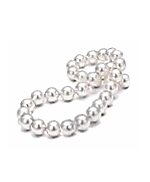|
|
|
 |
 |
 |
 |
|
 |
 |
 |
 |
|
 |
|
 |
 |
 |
 |
 |
 |
 |
 |
|
 |
|
 |
|
 |
|
 |
|
|
|
|
|
|
 |
|
 |
|
|
|
|
|
|
|
 |
|
|
 |
 |
 |
 |
 |
 |
 |
|
|
Pearls
|
|
|
|
The sparkling beauty of a strand of pearls has held the attention of brides for millennia. The ancient Greeks believed that wearing pearls would promote marital bliss and prevent newlywed women from crying. During the Crusades in the Middle Ages, pearls were the gift of choice for a knight to give to his lady. During the 14th and 15th centuries, royal wedding scenes closely resembled a sea of pearls, with everyone from the bride down to her male guests adorned with impressive arrays of pearl jewelry.
In modern times, cultured pearls have graced such 20th century brides as Queen Elizabeth II, the late Jacqueline Kennedy Onassis and Elizabeth Taylor.
|
|
|
|
 |
|
|
|
You may have seen the term "cultured" preceding the word pearls at your jewelry store. Cultured pearls are pearls that are nudged to life when a worker surgically implants a tiny bead into the oyster (that's the shellfish in which pearls grow). The host oyster is then lowered back into the water and, if all goes well, it deposits layer upon layer of a substance called nacre around the bead, eventually forming a pearl large enough to harvest. Of course, some oysters continue to produce pearls without any help, forming nacre around a natural irritant that gets inside their shells, they are rare however. Culturing produces far more pearls than nature could alone.
|
|
|
|
The Essentials of Pearls
|
|
|
|
luster
|
|
|
Of all in cultured pearls, luster is perhaps the most important. Fine luster produces an almost mirror-like reflection on the surface of pearls, when looked at in normal light. You should avoid cultured pearls that look dull and chalky.
|
|
|
|
Surface
|
|
|
The surface of a cultured pearl should be relatively clear of blemishes, pockmarks and pits. Since cultured pearls are grown inside an oyster, it's very rare to find a completely blemish-free pearl. But the fewer the blemishes, the greater the value of the pearl. Sometimes if these imperfections are near the drill hole of the cultured pearl, they will be less noticeable in a necklace.
|
|
|
|
Color
|
|
|
|
Color in pearls is a preference often based upon geographical location or skin tones. In the U.S., white pearls with a slightly pink overtone tend to be the most popular, although pearls with a golden tone are gaining popularity.
|
|
|
|
Size
|
|
|
Size is another factor best left to personal preference. Some people like smaller, more delicate cultured pearls, from 3.0 mm to 5.0 mm, while others like larger pearls, 6mm and up. Size does affect price; usually the larger the pearl, the more valuable it is. Factors such as luster, however, also have an effect on price - a smaller pearl with better luster can sometimes equal the cost of a larger, less lustrous pearl.
|
|
|
|
Shape
|
|
|
|
For many wearers, roundness in cultured pearls equals perfection, and it is the traditional sublime shape. But modern tastes vary, and you may want to explore baroque, or irregularly-shaped, cultured pearls. Baroque pearls, for example, more often flash with "orient," a display of iridescent colors that moves across a pearl's surface.
|
|
|





